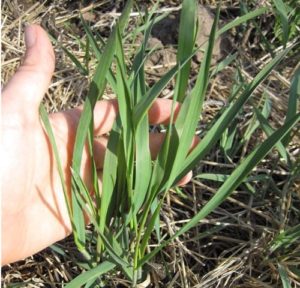GARDEN WORKS: Is spring really here? Tips for a productive garden this time of year
 by Emily Cates
by Emily Cates
Well, lookie here! Could it be? Why, yes, I think it is! Finally, the moment where I can actually go out to my garden and really feel like I can do something other than twiddle my green thumbs while looking at seed catalogs. The snow has melted in most parts of my lawn, and well-drained areas and raised beds are ready to be worked. And I figure it’s good to get going before the going gets good for the pesky black flies. I’m sure all of us who love to be outdoors can appreciate that, so let’s take a look at a few activities we can do to welcome Springtime. We’ll make sure the soil is ready to work with, and things we can do whether it is or not.
How do we know if the ground is ready to be worked? The soil should have the consistency of a wrung-out sponge when squeezed. If it forms a sticky ball, be patient and wait for the ground to dry out – or you’ll run the risk of damaging the soil structure.
Raised beds have a great advantage this time of year, as they are usually well-drained and ready to be worked before lower-lying areas of the garden. (I dug one up the other day and could’ve planted it if I had time!) I prefer to mulch my raised beds heavily if I get around to it in the fall so that when I dig them up in the spring, they are much easier to work. However, since mulch can hold in the cold, it might be a good idea to move it to the side in early spring until the soil has warmed, and then replace after the bed is planted.
The plots in my garden that I care for are dug exclusively by hand with a spading fork. Of course it would be easier to till with motorized equipment, but I do have weeds like quackgrass that spread by rhizomes.
To chop them into the soil would simply multiply them beyond my management capabilities – more work for me than just digging by hand and meticulously removing as many weeds and roots as I can while preparing a bed. I’ve found that over the years, I have less and less of a quackgrass problem when I carefully dig by hand and mulch – either with living mulches and cover crops such as oats – or straw, cardboard, old wood chips, or black plastic mulch. Now if only my aching back was as pristine….
The best plants for cold weather include kale, spinach, peas, carrots, leeks and other alliums. And don’t forget that trees, shrubs, and vines should be planted while they are still dormant – a ways before most garden plants are ready to plant. As soon as you can dig a hole, you can plant a tree! Don’t wait for it to warm up to do this if at all possible. (See details for the FEDCO Tree Sale below!)
Cold frames, hoop houses, high-tunnels, row covers, and similar items combined with cold-loving plants can really jump-start the season. Be sure to make good use of them if you have them handy.
Oftentimes there is no getting around areas that are slow to warm. North-facing places, especially, are the last to be ready for action. At times, this can cause considerable delay, though there might be a couple of things we can do. Some folks cover the area with a layer of clear plastic to help it heat up. Another possibility is container gardens: just fill large tubs with the planting mix of choice and go from there. Black containers will heat up their contents quicker.
If working the soil and planting is just not an option, it might be good to put some time into preparation, such as building up a compost pile and a mulch heap in a handy place near the garden. Stocking up on soil amendments is never a waste of time, as is clean-up of plant residues from the previous season. Without a doubt, we can find something to do!
Few things get me in the mood for Springtime more than the annual FEDCO Tree Sale. Located on the Hinckley Road, in Clinton, the sale runs Friday and Saturday, May 4 and 5. Be there if you can, you won’t regret checking out their vast assortment of everything you can imagine growing in your garden and the supplies to help you. It’s a lot of fun and a perfect trip to take with family and friends. See you there!
Responsible journalism is hard work!
It is also expensive!
If you enjoy reading The Town Line and the good news we bring you each week, would you consider a donation to help us continue the work we’re doing?
The Town Line is a 501(c)(3) nonprofit private foundation, and all donations are tax deductible under the Internal Revenue Service code.
To help, please visit our online donation page or mail a check payable to The Town Line, PO Box 89, South China, ME 04358. Your contribution is appreciated!



Leave a Reply
Want to join the discussion?Feel free to contribute!